![]() 美の糧を繋ごう 2018-2028
美の糧を繋ごう 2018-2028
万物万人に敬意を表す
Who we are
教育理念
マリアズベビーズソサエティーは1986年に東京都南麻布恩賜財団母子愛育会内にて創立した
渋谷区神宮前の幼児教育を専門とするプリスクール・キンダーガーデン・インターナショナルスクールです。
私共は園児の教育を中心に、園児、園児の母親、園児の両親、三者の指導を行います。
すなわち、我が子の成長の機会を生かして三者全員が共に学び成長し
子と家族が一体となって未来を創造する事に私たちは教育の本質を見出しております。
Maria's Babies Society is a preschool and kindergarten founded in 1986 in Minami-Azabu, Tokyo
in association with The Imperial Gift Foundation of Aiiku Society.
We focus on providing guidance to the children, their mothers and their family.
In other words, all three parties learn and grow together,
and the whole family evolves by making the most of the opportunity that is the child's developmental pathway.
We see the essence of education in the child and family working together to create the better future.
What we are

幼児教育の基本は
子の「天性」と向き合う事と
マリアズ ベビーズ ソサエティーは考えます。
子どもの清い目で見つめると、全ての子の「天性」はいかばかり美しく特別でしょうか。
子は自らの天性を軸に成長進化する事を望みます。
それが自然だからです。
大人はその可能性を大切に
隣の子がどうであるとか、数字で判断される結果等に惑わされる事なく
その子が持って生まれた「ギフト」と向き合う経験を
父母が成長する為の「ギフト」として受け止め
その力が活かされる様
心を込めて子を導き
辛抱強く楽しみに待つのです。
我が子の「天性」を生かし輝かせる道は
父母、家族の「本当の姿」と向き合う長い長い道です。
ある意味において、子の成長という未来のために、父母それぞれの家族の歴史に遡り、事実と向き合い、
それらを感謝し、超えていく一族の課題でもあります。
子と家族がひとつになって成長する事こそが、社会・ソサエティーの進化の礎となります。
マリアズ ベビーズ ソサエティー
The House Number II
「第二の我が家」は
優れた環境と導き手をもって、豊かな根を子どもの心に育て
ソサエティーの役割を果たし続けます。
教育思想

Maria's Babies Society believes that the basis of early childhood education is
to nurture the child's natural gifts.
How beautiful and special is the ‘natural constitution' of each child when seen through the child’s own pure eyes.
The child wants to grow and evolve around his or her own innate nature.
This is because it is in harmony with nature.
Adults around the child should cherish that potential.
We should not be misled by what other children are like or by quantitative assessment results.
Parents should accept the experience of facing the child's ‘gift‘ as a ‘gift’ for their own personal growth and development.
To make the best use of that potential,
guide the child with all your heart and
patiently wait and look forward to it.
The path of refining the natural gifts of the child is also the path whereby
parents and families face who they really are.
In a way, it is the family’s task to go back to the family history of each of the parents, to face the facts,
and to appreciate them and transcend them for the child's future and for the next generation.
Indeed, the growth of the child and the family as one
is the basic foundation for the evolution of society.
Maria's Babies Society
A home away from home
The 'second home' nurtures rich roots in the child's heart and mind.
With an excellent environment and guiding hands,
Society continues to fulfill its role.
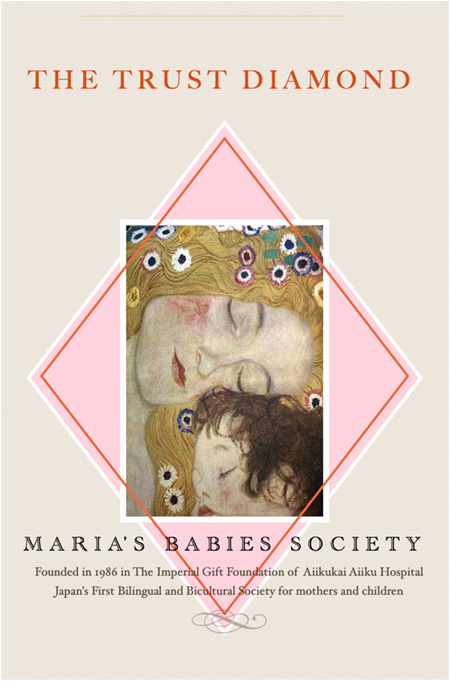
世界的パンデミックを超え
マリアズ ベビーズ ソサエティーが
目指す教育
下をボタンをクリックをして
PDF ダウンロードの上ご高覧ください
PDF
Durch Leiden Freude
Ludwig van Beethoven
1770~1827

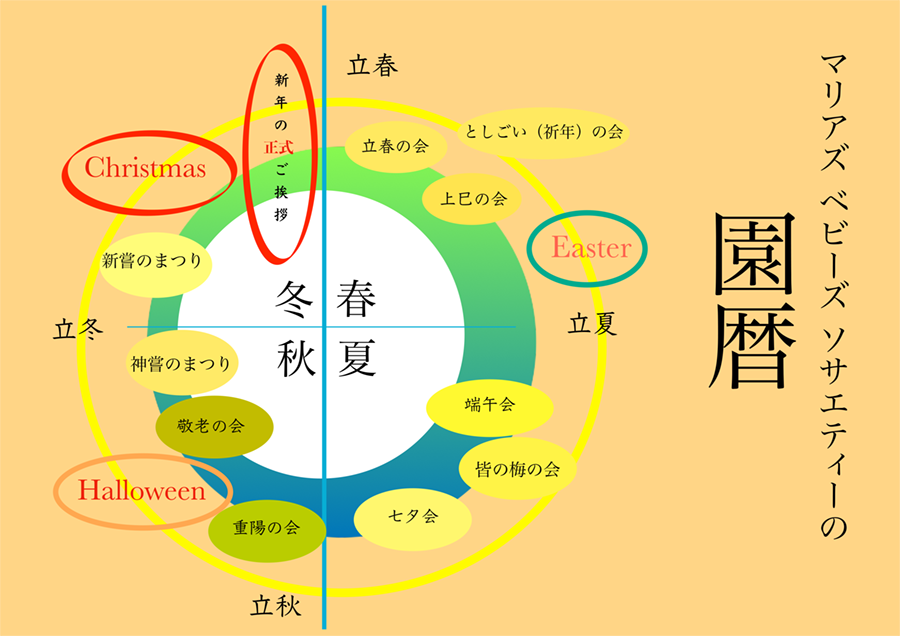
橿原のとほつみおやの宮柱
たてそめしより国はうごかず
明治天皇御製 明治四十二年
Once our ancestor
set that pillar of our land
at Kashihara
as our country's foundation,
this nation has not wavered.
御製 Gyosei by Emperor Meiji 1909
マリアズ ベビーズ ソサエティーの教育は同年齢や、縦割りの子供同士の「遊び」を重んじながらも美術、音楽、美しい日本語、英語教育と日本の伝統文化、歴史を豊かに統合した、他に類のないものです。人格形成において極めて重要な幼児期に愛情溢れるきめ細やかな少人数環境で築かれたこの基盤は一生の宝となる事でしょう。

万物万人に敬意を表す
What we value
幼児期に
感性の育成を
マリアズでの子供達の生活には「豊かな季節感」と「伝統的な色彩の言葉」があります。
日本的感性の源はこの国の気候風土に始まります。
研ぎ澄まされた五感を「自然への感謝と畏敬の念」に重ね
先人達が紡ぎ続けた文化は、世界にも稀な豊穣で成熟度の高い文化です。
日本人の感性の本質に触れる為の最初の一歩となる軸として
子供達の日々の生活環境には次の
暦・二十四節気」と「日本の伝統色名」があります。
この類稀な成長の為の環境で、子供達のみならず家族の皆様にも
文化の香り溢れる、豊かな日常生活を経験して頂きたいとマリアズは願います。
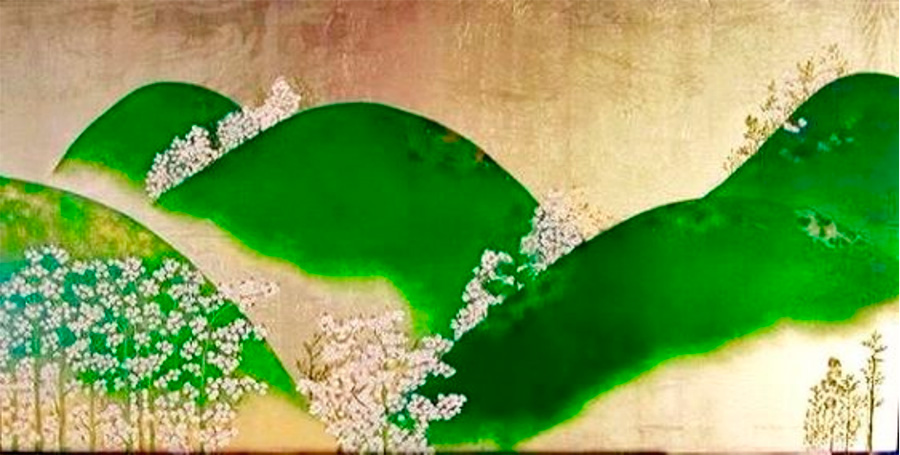
「よく見ること」
すべての学びの基本
日本は、「鬼の観察眼と菩薩のおおらかさ」を持って、「四十八茶百鼠」等に表される様な、極めて繊細な色彩文化を構築しました。その豊かさに富んだ色の世界観は「日本の伝統色名」の奥行きに表現されています。子供達が、「鋭く観察する目と豊かな言葉のセンス」を育てる為の感性教育のひとつとして、「本物を見せ、それに授けられた名前の世界を、親子で拡げていく」そのような日常はいかがでしょう。さあ、外に出て、花でも木でも、空でも雲でもなんでもいいです。よく見てみましょう、そしてその色に授けられた名前を知り、漢字で書いてみましょう。声にして、その音の響きに耳を澄ませてみましょう。何か世界がズンッと拡がる感じがしませんか。内なる世界が豊かになった気がしますよ。
二十四節気の展開と共に、日本各地の豊かな自然や文化の「姿」又その色名と文化をこちらに共有致します、
ご家族の色彩世界を広げ、日本人の豊かさを深める為の参考にしていただければ嬉しく思います。

清明
Fresh Green
Bright pale yellow Kuzusou cosutume
Kuzusou cosutume
淡黄蘗(うすきはだ)
国栖奏の装束
4/4 〜 4/19
The children’s daily life at Maria’s Babies Society
is imbued with a well-defined sense of the seasons
through the 24 solar terms and the traditional language of colours.
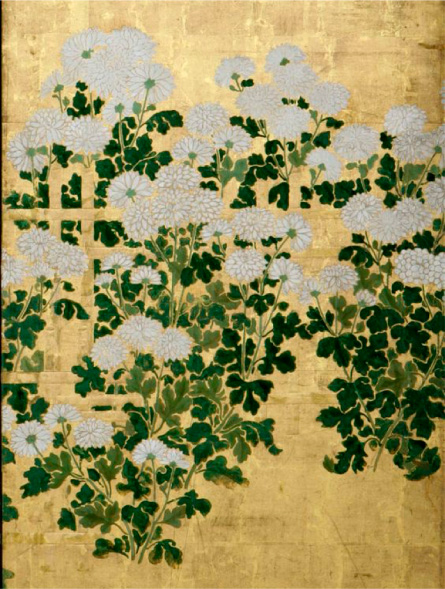
The source of Japanese sensibilities is the country’s climate and terrain. The unique Japanese culture that our ancestors have established with their acute sensitivities is characterized by ‘gratitude and reverence for nature’. It is a highly-refined and rich culture, even when viewed from a global perspective.
Early childhood exposure to these cultural values, which are embodied in Japanese virtues and aesthetics, serves as the foundation for nurturing future generations who can make a positive contribution to the global community.
The 24 solar terms (periods) of the traditional Japanese calendar, along with the traditional Japanese colour names, are employed at Maria’s Babies Society as one of the core learning elements for children to become acquainted with the essence of Japanese sensibilities.
This rare and rich learning environment is designed to benefit not only the children but also their families, offering them the opportunity to experience rich authentic Japanese culture during their daily experiences at Maria’s Babies Society.
ART OF 躾
SHITSUKE

美しい「日常」の教育
「身に美しい」
と書いて「躾」
躾の原泉は 倫理観とひとつ
日々の生活の中で
何が恥ずべき事か 何が誇りか
何が許されぬことか
「真善美」を軸に
日々「本質」を幼児にわかる言葉で示す
身につくまで日々繰り返し
第二の天性として備われば
それは我が子の内なる
Arts and Habits
元気の良い「返事」と「挨拶」
相手の目を見て話すこと
心からの「ありがとう」と「ごめんなさい」
妹弟や祖父母への「お先にどうぞ」
過去・現在・未来に於いて不変であり続ける
社会生活の基礎中の基礎
知らず知らずに身に付けさせる
これ以上ない大切さ
幼児期
感性教育の黄金期

「正解のない」感性の時代
幼児期はまさに感性教育の黄金期
日々の生活において
美しい「人 物 事」に触れさせ
「美しい姿」を示す
感性を育てる美しさとは
本質的な「真善美」を内包した
日常の行いや言葉
神話や民話 音楽 美術
古典や大自然という
「大きな器」に導き
解釈を教えず
子供の成長と共に 自ら意味を求めさせ
今は只その姿に触れさせる 深い意味
幼児期は美意識や倫理観の軸を立て
その記憶は子の成長をかたどり
後々の人生を導き
時に救う
「天地の美に原(たず)ねて万物の理に達す」
古の荘子の教えが21世紀の幼児教育に深く響く
![]() 美の糧を繋ごう 2018-2028
美の糧を繋ごう 2018-2028
万物万人に敬意を表す
綺麗好
KIREIZUKI
Bringing the wonders of Japan to children
and their parents around the world
Since the pandemic ended, I have had the privilege of
meeting numerous children and their parents from around the world.
Most of them express a deep affection for Japan,
their eyes radiant with admiration for our culture
and their minds actively seeking to learn more about this country.
I am impressed by the positive energy
I see in these children, and I am equally impressed by their parents, who support the development of
a multifaceted individual and cultural identity in their children.
I sense and I hope that they will grow up to forge a more connected,
stable and richer global peace in the future.
It is with them in mind that we have created
綺麗好 KIREIZUKI to bring
Japan's wonderful cultural heritage to the world's younger generation.
This is part of our ongoing commitment
to the credo at the heart of Maria's Babies Society:
Better Education, Better World.
綺麗好 / KIREIZUKI
日本文化の素晴らしさを世界の子供達へ
世界には「日本が大好き」な子供達が沢山います。
パンデミック終了後に出会った多くの「日本が大好き」な子供達は
キラキラとした綺麗な瞳を輝かせ
日本について知りたい、学びたい、身につけたい、と積極的に多くを問うてきます。
純粋で明るく強いエネルギーがそこにはありそこには大きな希望があります。
まごうことなく
日本の文化は素晴らしい。
こちらからのセクション
「綺麗好」は
世界の「日本が大好きな子供達」とその家族に
日本の素晴らしさを伝える
マリアズ ベビーズ ソサエティーの
新たな取り組みです。
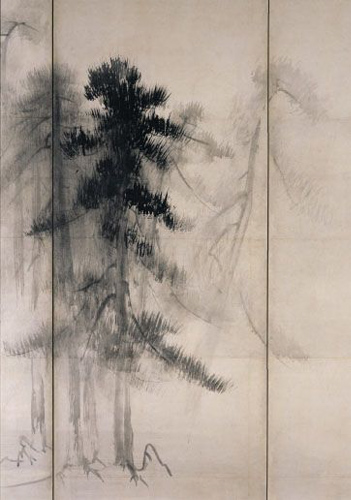
KIREI*ZUKI
Love of Cleanliness & Purity
綺麗好について右のPDF資料、
またはYouTube動画をご覧ください
For full details of this column
“綺麗好 / KIREI-ZUKI”,
we invite you to explore
the PDF document or
the You Tube video below.
新型コロナ感染症パンデミックがきっかけとなり始めた明治神宮での御千日参りで、私は毎日世界各国の人たちと出会い、日本の文化、歴史、伝統、また神道・明治神宮などについて語り合って参りました。気がつくと、2024年の初夏、お参りは六百日が過ぎました。世界の人々との対話のテーマが、日本から始まり、平和、未来そしてその先は例外なく「教育」へと広がる毎日に、言葉では言い尽くす事のできない感謝を実感しております。
KIREI-ZUKI -このコラムの取り組みの原点は、その世界の方々との一期一会の対話にあります。
海を超えて日本にいらして下さった皆様方は、日本の伝統は素晴らしいと絶賛して下さり、「神道の大切な教えは何か」とお聞きになります。私は、神様が喜ばれるように「心が綺麗」である事、その為に、心身を祓え清める事 は神道ではとても大切であると、幼稚園児でもわかる様な事から話します。KIREIZUKI・綺麗好というタイトルはこの考えを原点にしています。日本語の綺麗は clean であり、クリーンとビューティフルが同一の言葉「綺麗」である事を、私たち日本人が日常で意識する事はあまりないと思いますが、この二つの言葉の同一化は、大変日本的な価値観、また美意識と言えると思います。神様は綺麗がお好きで、日本人には綺麗なことは「美しい」のです。
また多くの海外からの皆様は、この広大な明治神宮の何処へ行ったら良いのかをお聞きになります。素晴らしい対話の機会を下さり、遥か遠くからいらした方々に、感謝を持ってお答えする為に、こちらに明治神宮の素晴らしい場所とその周辺の事柄についてまとめました。この様な場を設けましたのは、ヨーロッパ、アジア、中東、ロシア、インド、アフリカ、アメリカ合衆国、他からいらした世界の皆様との熱心な対話の最後が、必ず「教育の大切さ」でいつも結ばれるからです。私の生業のクレドである「未来は教育あってこそ」という一点に、世界の多くの皆様の想いが重なる事に大きな希望を実感し、何か私から役に立てる事はないかと考えたからにあります。この様に明治神宮の素晴らしさを共有する事をスタートとして、徐々に共有内容を広げることによって、世界の人々と、日本の類稀な伝統文化を通じて教育というものを新たに見つめ直し、よりよい世界を目指す一歩にしては如何かと感じたからです。
また、多くの方々は和歌とは何か、御製とは何かとお聞きになります。日本人でも御製とは天皇様がお詠み遊ばされた和歌である、と即答できる方は少なくなって来た事と思います。私は和歌こそが、日本の子供達に伝えたく、又、同時に今日失われつつある日本の誇るべき伝統文化であり「完成された美意識のかたち」であると答えています。又、和歌は古から受け継がれた日本人の心性、感受性を磨き上げてきた「器」とも言えるのではないかと感じます。神話の昔から「限られた語数という秩序」の中で、「自由な個の心の世界」を、言葉とその響きを以て培い磨き上げ、後世に繋いできた日本人の尊い「姿」なのです。
この幅広い皆様との日々の交流において、これからも教育について対話を続け、同時に日本の素晴らしさを伝え、それが海外の皆様の日常に活かせる価値観や気づきなどに繋がれば幸いです。日本の素晴らしさ、明治神宮や神道的思想の素晴らしさ、並びに明治天皇が61年の御生涯で残されたおおよそ10万首の御製、その他日本の素晴らしい言葉の文化、それらを育んだ日本の四季等についてお伝えする事にささやかながら取り組んで行きたいと思います。それが奇しくも、私たち日本人が忘れかけている「日本の特別な素晴らしさ」を学ぶきっかけに広がる事、「記憶に遠くなる日本へのルネッサンス」となり、人々の幸せに貢献できる子供達が育つ事を心から願います。
マリアズ ベビーズ ソサエティー
園長 松岡まりあ
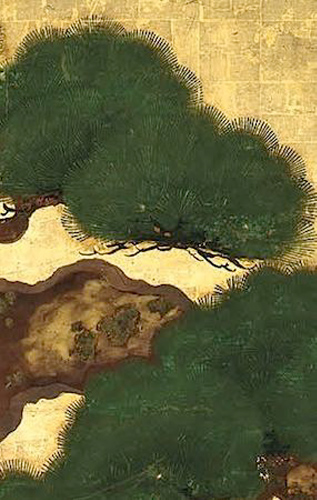
A Renaissance
of
Our
Forgotten Japan
The COVID-19 pandemic triggered me to start 御千日詣り (O-Sen-Nichi Mairi) (Thousand-Day Pilgrimage) to Meiji Jingu Shrine, where I meet people from all over the world every day to engage in discussions about Japanese culture, history, and traditions as well as Shinto beliefs and Meiji Shrine itself. Before I knew it, 600 days had passed, as of early summer 2024. The dialogues with people from other countries starts with Japan itself and then extends to peace, the future, and invariably, to the topic of education, which gives me a deep sense of gratitude that words cannot fully express.
The starting point of this column, which is entitled, Kirei-Zuki (綺麗好), is these once-in-a-lifetime dialogues with the people of the world.
Those who come to Japan from across the seas praise and show great respect for Japanese traditions, and they often ask what is important in the 神道 (Shinto) religion. I explained it in a way that even a kindergartener could understand, that our heart must be clean and pure to please 神 (Kami) (the gods); thus, purification of the physical and the spiritual entity is the core, essential belief. The title of this column, Kirei-Zuki (綺麗好), is based on this principle. The Japanese word “Kirei (綺麗)” is for ‘beauty’ also means ‘clean’, and we Japanese are not even very aware that this single word in Japanese is divided into two separate words in English. I think is the foundation of the very distinctive Japanese aesthetic sense. The Japanese deity (神様) (Kami-sama) loves cleanliness and purity; thus we Japanese naturally believe that cleanliness and purity are beautiful.
Many visitors from overseas also ask where to go in the vast Meiji Shrine complex. As an expression of gratitude to those who have travelled a long way to visit the shrine and take time to engage in these meaningful dialogues, I have compiled a list of places in Meiji Shrine where one can feel and sense something beyond words, which I introduce in this column. The main reason why I have established this column, Kirei-Zuki 綺麗好, is because the enthusiastic conversations with people from Europe, Asia, the Middle East, Russia, India, Africa, the US and many more always seem to end with the importance of education. It reassures me and gives me a great sense of hope when the concerns of so many people in the world match my own professional credo, ‘the future depends on education’. By starting with a list of such places in Meiji Shrine and gradually expanding the content, I feel that this can be an opportunity to look at education in a new light through the unique culture of Japan with people from around the world, with the common goal of creating a better world for us all.
Many people also ask what 和歌 (Waka) is and what 御製 (Gyosei) is. I think that even among Japanese people, there are fewer and fewer people these days who can explain precisely that the Gyosei are Waka poems composed by Emperors of successive reigns. I explain to them that Waka, literally meaning ‘Japanese poems’, is a traditional form of literary expression that embodies a wealth of subtle Japanese sensitivities. Unfortunately, this invaluable historical treasure is being lost in the midst of our modern and contemporary Japanese lifestyle, and this is exactly why I want to pass it on to future Japanese generations. I feel that Waka poetry can be described as a ‘vessel’ that has passed down and refined the Japanese mentality and sensitivity since ancient times. Since the time of mythology, these poems have cultivated and refined the ‘world of the free individual mind’ within the structural confines of a limited number of syllables, via the meanings of words and their sounds. Indeed, I think that Waka is one of the precious 姿 (Sugata/forms) of Japanese-ness and the Japanese culture.
Through the truly rich and engaging Osen-Nichi daily ritual, I will continue to hold dialogues with people from the world. From the perspective of education, which is always at the core of my thinking, I shall gradually share about Japanese tradition, culture, the four seasons, Waka, and the 100,000 Gyosei which Emperor Meiji created during his 61 years of life. It is my hope that this can provide new values and insights to people from a wide range of different cultural and historical backgrounds. At the same time, I pray that it will also be an opportunity for us Japanese to learn about our own culture, a challenge which must be taken seriously. I hope this leads to a ‘Renaissance of Our Forgotten Japan’.
Maria's Babies Society
Headmistress
Maria Matsuoka
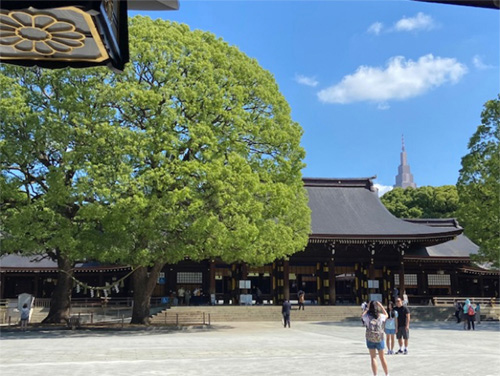
明治神宮御本殿
Meiji Jingu Main Sanctuary
申すまでもなく誠に神聖でちりひとつない清らかで「綺麗」の極みです。
言葉は何一つ必要ないと思います。
神道には祝詞という「言葉」があります。
キリスト教などで言われる「祈祷」とは違いますが、
神に奏上する意味では同じです。
祝詞は大変・神聖な響きがして、朝と昼の御饌の時にご神職様が祝詞を奏上する、
その響きを耳にすることができます。
御饌「神様のお食事」は朝の8時と午後2時に行われます。
ぜひ親子で御饌の時間にいらして、祝詞の言葉¨の響きに触れてみてはいかがでしょうか。
神聖な日々の祭事と「祝詞」の響きに日本の「綺麗」の本質を耳から感じで頂けるかと思います。
Needless to say, it is a sacred place that is free of dirt and pure
the ultimate example of beautiful ‘cleanliness’.
I do not think any words are necessary to describe it.
A Shinto ritual includes the chanting of ‘congratulatory words’.
It is not the same as a Christian ‘prayer’,
but it is similar in the sense that it is addressed to the deity.
The words have a very sacred sound, and you can hear the priests performing them
in the morning (8 a.m.) and afternoon (2 p.m.).
Parents and children are welcome to come and listen to the sound of these Shinto prayers.
These sacred daily rituals and the echoes of the 祝詞 (Norito/prayers) will give you a taste of the essence of Japanese Kirei (beauty).
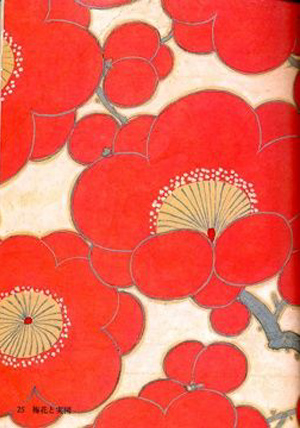
明治神宮内苑・御苑
Meiji Jingu Inner Gardens and
Imperial Gardens
この庭は春夏秋冬を通して美しく、お茶室「隔雲亭」から昭憲皇太后がお釣りされたお釣り台が望めます。明治の大きな時代のうねりの日々を、昭憲皇太后はどの様なお心持ちで南池の風景をご覧になられたのか、御庭を訪れる方々が想像を巡らせながら感じる事ができるかと思います。初夏の菖蒲園も素晴らしくお花にはひとつひとつ、素晴らしい銘が記されています。海外から訪れた親子の皆様にはぜひその名前の意味を調べて子供達に教えてやって下さい。品格のある大きな御庭はさながら迷路の様でもありますが、子供達は武蔵野の昔を彷彿とさせる、植物に抱かれたこの庭の自然から何かをきっと感じてくれる事と思います。
The gardens are beautiful throughout the spring, summer, autumn and winter.
From the tea ceremony room 隔雲亭 (Kakuun-tei),
you can see the fishing platform where Empress Dowager Shoken
The iris garden in early summer is also wonderful, and each flower has an inscription with rich meaning. Parents and children visiting from overseas are encouraged to look up the meanings of the names and tell their children about them. These names may give you some hints that will help you learn more about Japan. The large, elegant garden is like a maze, but the children will surely feel something specialfrom the nature in this garden, which is surrounded by plants reminiscent of the old Musashino Region.
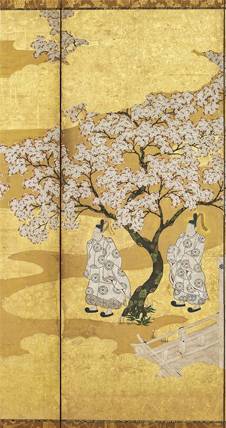
明治神宮
陛下の「秘密の森の道」
His Majesty’s Secret Forest Path
原宿門から一礼をして参道に入り、間も無く左に折れる道を曲がります。秘密と記しましたが、入ってはいけない道ではありませんので、誰も入れない秘密の道ではないのですが、この角を左に曲がる方をまず見かける事はありません。宝物殿に出るまで子供の足で10~15分はかかるであろうこの森の道は、あたかも森の木々の会話が聞こえてくるような、否、神宮の森の話を聞いてちょうだいな、と語りかけて来るような不思議な穏やかさを感じる木々の道です。至誠館の稽古に週何回も通っていた頃、この道でいろいろな動物にも出会いました。
捨てられた兎を保護した事もあります。
至誠館で、故田中茂穂名誉館長先生のお稽古を楽しみに息子達を連れて、
この森を親子で歩く事ができた幸せに感謝しています。是非この渋谷区の地に創造された、
日本全国からの御献木の陛下の森、陛下の秘密の道を子供達と語り合いながら歩いてみて下さい。
きっと親も子も其々に何かを感じる事と思います
I refer to it as a secret forest path, but after bowing at the Harajuku Gate and starting down the main path to the temple, there is a path off to the left. It is not a secret path that no one is allowed to enter, but you will rarely see anyone turn left at this corner.
This route to the Treasure Hall, which takes 10 to 15 minutes on foot for children, is a forest path with mysterious calmness, as if you can hear the forest trees talking to you, or rather as if they are telling you to listen to the story of the Shrine Forest. When I used to go to practice martial arts at Shiseikan training hall several times a week, I met many animals along this path. I even aided an abandoned rabbit once.
As a mother, I am grateful for the invaluable experience of being able to walk through this forest path with my boys. Needless to say, we also appreciated the lessons we received from the late Shiseikan director, Shigeho Tanaka-Sensei. Please find time to walk through His Majesty's secret forest path with your children. I am sure that both parents and children will feel something special!
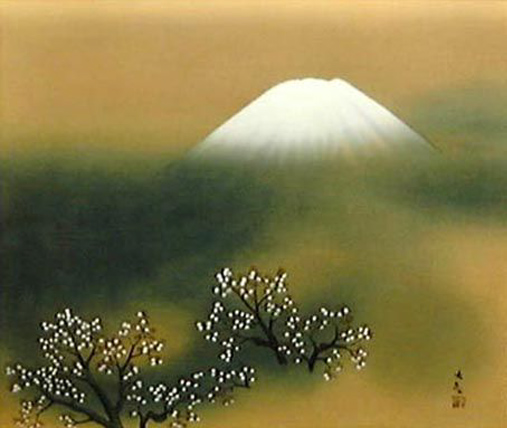
明治神宮 武道場 至誠館
Meiji Jingu Martial Arts Hall 至誠館 Shiseikan
この類稀な稽古場で故、名誉九段、田中茂穂先生から賜った稽古の日々は私にとってのかけがえのない宝です。神宮は思想のみでなく、物理的にも「綺麗好・きれいずき・KIREIZUKI」です。稽古の前には皆総出で、掃き掃除、畳の雑巾掛け、お榊の水換えなどをさせて頂きます。陛下の森にいただかれる様にあるこの稽古場には、
他のどこでも感じる事のない神聖な気が漂っています。
心を込めて掃除をし我が子達の隣に一列に正座し、静謐な沈黙の中で師範を待った昔を思い出します。
田中先生がお出ましになられ皆で御祭神に、二礼二拍をすると、
田中先生はいつも短く、大変深く心に響くお話しを三歳の子でもわかるようにして下さいました。
ある初春の日先生は、
「春になったね、明治神宮の森にもたくさん綺麗なお花が咲き始めたね。
僕たちはあのお花はなんであんなに綺麗に咲くかわかるかな?
あれはね、みんなが見ていても見ていなくてもとても綺麗に咲くんだよ。誰も見ていなくても一生懸命に命の力を全部注いで綺麗に咲くんだよ。みんなもそうであるといいなと思うよ」
至誠館は子供達にこの様な言葉を下さった尊い場です。もちろん国際親善の要素も武道の普及を通して行なっていますが何よりも、陛下の残してくださった新しい東京の「特別な自然」と「古き良き日本の心」が共に在る場、
と私は思っています。
お稽古の見学などは、お電話で問い合わせが必要と聞いていますが、その価値はある素晴らしい日本の教育の場を 日本滞在の折に親子でご覧になって頂きたく思います。きっと何かを感じて頂けると思います。
The many days of aikido training given to me by the late Shigeho Tanaka-Sensei, honorable 9-dan (9th level), at this exceptional training hall are an irreplaceable treasure for me.
The hall is not only ideologically but also physically ‘Kirei-Zuki’ (clean and beautiful).
Before practice, we all work together to sweep and wipe the tatami mats
and change the water of the Sakaki branches.
This practice hall, which is like being surrounded by His Majesty's forest,
has a sacred atmosphere that you cannot feel at any other training hall in Japan.
Writing this reminds me of the old days when I used to clean the hall with all my heart, sit upright next to my children, and wait for the 師範 (Shihan) (the Master) in tranquil silence. When Tanaka-Sensei came out and we all bowed to the deity, Sensei always gave a short,
deep and moving talk that even a three-year-old could understand.
One day in early spring, he said,
“It’s spring now, and many beautiful flowers have started to bloom in the forests of Meiji Shrine. Do you know why those flowers bloom so beautifully? They bloom beautifully whether someone is looking at them or not. Even if no one is appreciating the flowers, they bloom beautifully by putting all their life force into it.
I hope it’s the same for you, too.”
This is the precious place where these words are delivered to children on a daily basis.
Shiseikan also promotes international goodwill through the spread of martial arts.
But above all, I believe that Shiseikan is a place where the ‘unique 100-year-old manmade forest of the new Tokyo’ left by His Majesty and the ‘traditional Japanese spirit’ can be found together.
I have heard that you need to make an enquiry by phone to visit Shiseikan,
but it is well worth the effort to visit this wonderful place.
Please experience Shiseikan during your stay in Japan.
Here, you will find the good old traditional Japanese education and values
which are being lost in Japan in the 21st century.
And I am sure you will feel something extraordinary at Shiseikan, a very special training school.
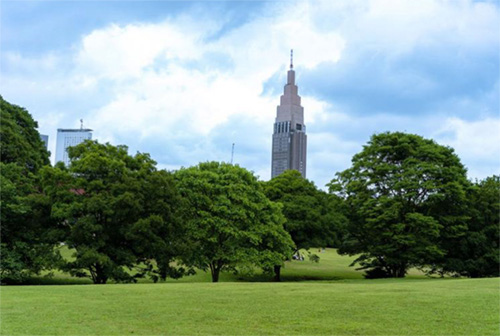
明治神宮宝物殿前の
森に包まれた明るい芝地
Bright green meadow surrounded by forest
in front of
the Treasure Hall
美しく立派で大きな広場です。広場は2面が傾斜をしており、なだらかな広場の傾斜の低いところにはささやかではありますが、水の流れも見られます。明治神宮の数少ない桜の中でも、特に風格のある大きな山桜も歩道の脇にあり、春にはこの老木が幹を上から下まで包むように胡粉色の清楚な桜の花が周りに溢れる様に咲きます。子供達と東京の自然に親しむにはこれ以上ない安全で幸福感に満ちた陛下の恵みを感じる広場です。ただこちらは公園ではありませんので、ボール遊びや飲食ではなく、明治神宮について、明治の杜について親子で静かに会話をしてはいかがでしょうか。
明治神宮についてわからないことがあれば、社務所で御神職の方にお聞きになれば良いと思います。私の御千度で出会ったインドのご家族の小学生の少年は、「先の戦争でこ神社の建物などはどれくらい残ったのか」などと大人顔負けの専門的質問を受けました。(南門以外は全焼だったと聞いています)この広場の借景は新宿の高層ビルとなります。我が子たちが幼い頃の借景は青空のみでした。この今の日本の景色と陛下の素晴らしい緑の広場で、日本を訪れた親子さんにはきっと何かを感じていただけると思います。
It is a beautiful, noble and large square. The square is sloping on two sides, with a modest but visible stream of water on the lower slope of the gently sloping square. Among the few cherry trees in Meiji Jingu Shrine, there is also a particularly stately large wild cherry tree beside the footpath, and in spring this old tree blossoms in a profusion of neat, cobalt-coloured cherry blossoms that wrap around the trunk from top to bottom. This is a safe and happy place for children to get to know modern Tokyo's nature and feel the blessings of His Majesty. However, this is not a park, so instead of playing ball, eating and drinking, why not have a quiet conversation with your children about Meiji Shrine and the Meiji Forest?
If you have any questions about Meiji Shrine, you can ask a priest at the shrine office. A schoolboy from an Indian family I met asked me technical questions like
"How many of the buildings of this shrine survived the last war?"
(I heard that all the buildings except the South Gate were burnt down.)
The borrowed view 借景 (Shakkei) of this square is the skyscrapers of Shinjuku.
When my children were young, the only borrowed scenery was only the blue sky. I am sure that parents and children visiting Japan will be able to feel something
from this current view of Japan and His Majesty's wonderful green square.
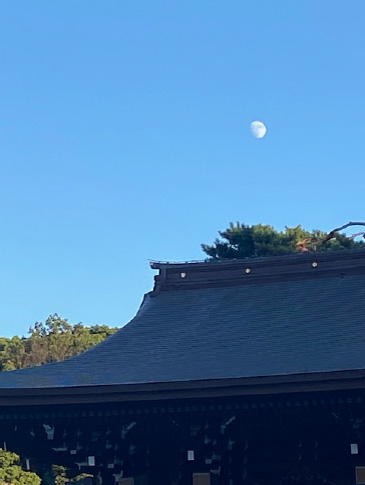
日本の神社やお寺とは、人々にとって
何かを感じる心の基柱
人々が大切な事を感じとり、
人々の学びの始まりとなるところ
Japanese shrines and temples are
anchors for the heart and mind
where people come to feel
something profound.
This is where we begin to feel what is truly
important and
where our learning begins.
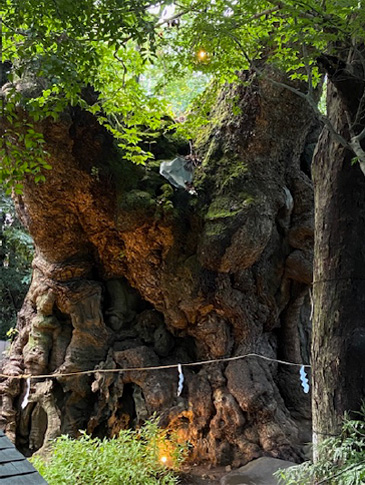
最後までご視聴くださり
誠にありがとうございました。
これよりまずは、御製、御歌、和歌などを、
二十四節気の流れに乗ってお伝えし、
皆様が日本の言葉の素晴らしさに
これからも触れて頂ける様に努めます。
また、明治神宮など、日本の神社やお寺を訪れた
皆様には、何を感じられたか、ぜひともこちらの
アドレス、shm@mariasbabies.co.jp 宛に
共有して頂けますと幸いに思います。
I would like to express my gratitude
to those who have read this article to the end.
My next step will be to update this website
regularly with new 御製 Gyosei, 御歌 Miuta and
和歌 Waka poems, following the 24 traditional
Japanese seasons.
This will allow our international audience to
continue experiencing the aesthetic qualities of
the Japanese language and culture.
I would also be delighted if you could share with
us what you felt when you visited Meiji Shrine or
other shrines and temples in Japan.
class="pc"Please send your messages to the
following address: shm@mariasbabies.co.jp.

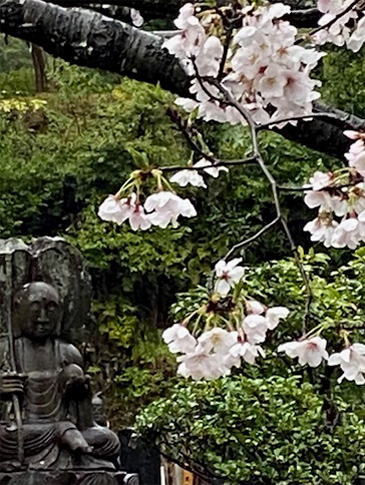
これからも、世界の国々の皆様と対話を重ね、
その実りをもとに、日本や世界の国々における
幼児教育(私の専門分野)、家庭教育、
親や家族の教育の、
守るべきもの、新たにすべきものを探求し、
綺麗好の次なる役割を確立して行ける様に
努めて参ります。
I aim to define the eventual role of 綺麗好
Kireizuki through dialogue with individuals
across the globe, both in person and online.
This process may serve as a valuable
opportunity to deliberate about what cultural
assets should be carefully preserved, with an
eye to respecting each nationʼs history and
traditions, and what elements should rightfully
evolve with the changing times, with particular
focus on the field of early childhood education.
綺麗好
KIREI*ZUKI
Love of Cleanliness & Purity
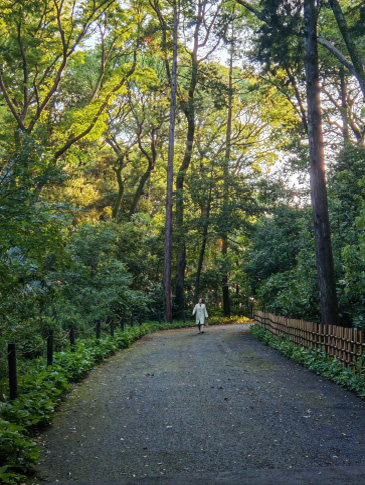


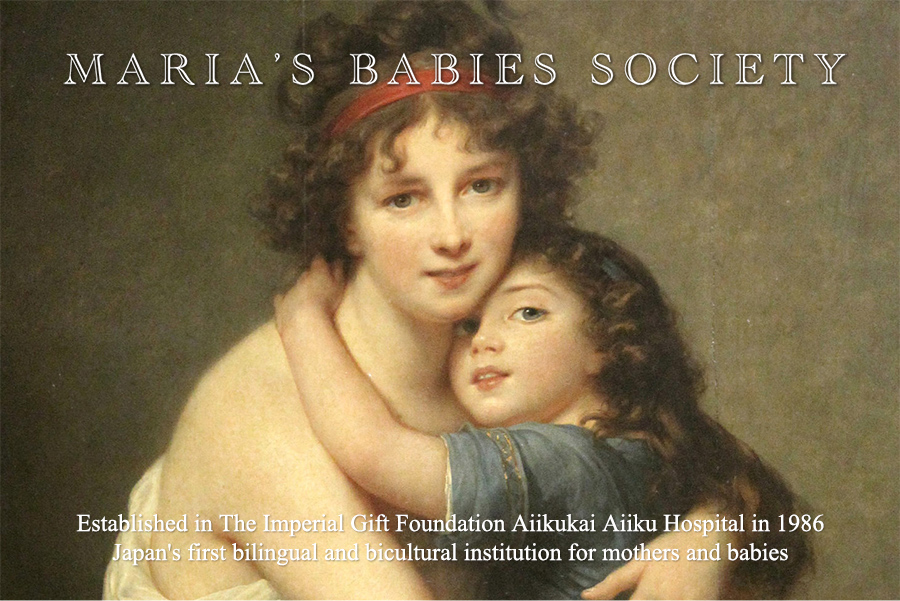
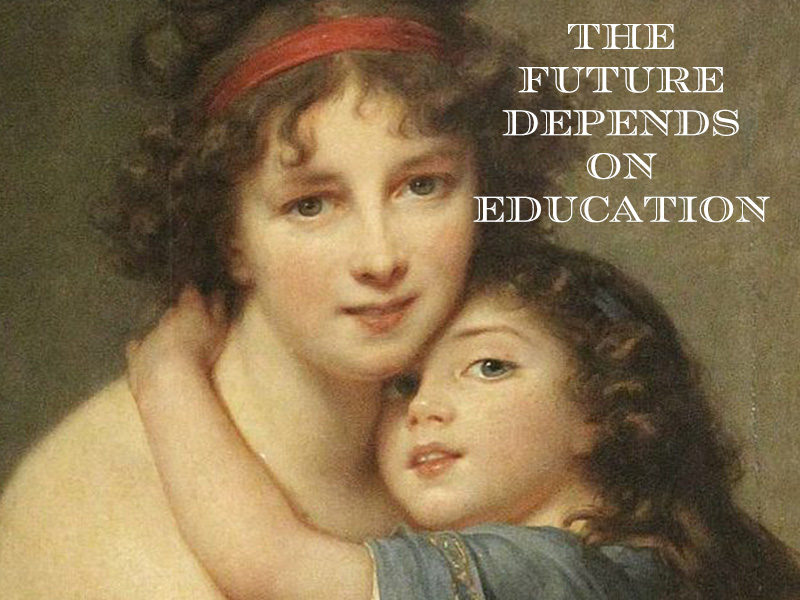
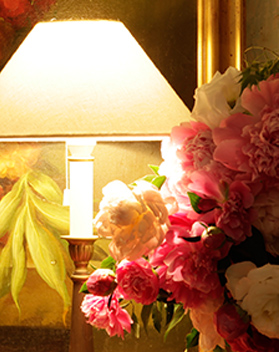
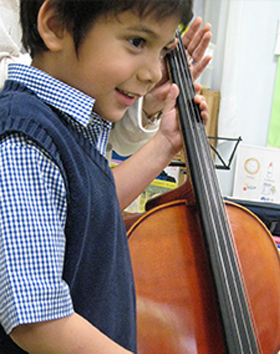
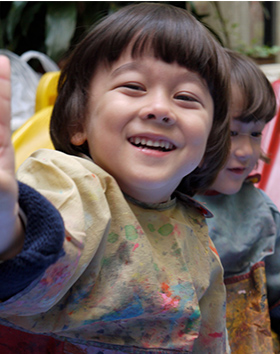
二十四節気:清明 4月 4日 ~ 4月 19日
奈良県橿原神宮の淡黄檗
色名のゆかり、そして子供達へ
東京や京都には、昨今残念ながら日本史の「素の匂い」がしない様に感じます。代わりに「歴史風カルチャー」もどきは、あちこちにぷんぷん漂っている様な印象を強くします。子供達の記憶に収めるべきは、歴史の根源となる「その土地が醸し出す香り」、そこに生息する木々や花々、昆虫や鳥などの動物たち、そして森があれば、その大自然のシステムが持つ調和のパワー等です。子供達に歴史文化の土台に触れさせる事が、その先に拡がる学びを確かなものにする為に極めて大切であると感じます。また、歴史の「本当の香り」が残っているところには「本物の色」が必ずあります。
奈良の南、橿原から吉野にむけての地域には「日本の原点」を感じます。神武天皇御即位2685年を寿ぐ、令和7年の国栖奏の御奉納、その御装束は、目前の立夏に繋がるこの時期に相応しい、まことに清々しい色目の装束です。袴の色である「甕覗(かめのぞき)」、単の「淡黄檗(うすきはだ)」狩衣には生絹(すずし/ 透明の白雪のような、透き通る白)などの動きを伴った色彩の世界観には「ああ、奥深い日本がそこにある。」と感じ得るものがあります。是非、親子、家族でそんな感動の時を持って頂きたく願います。